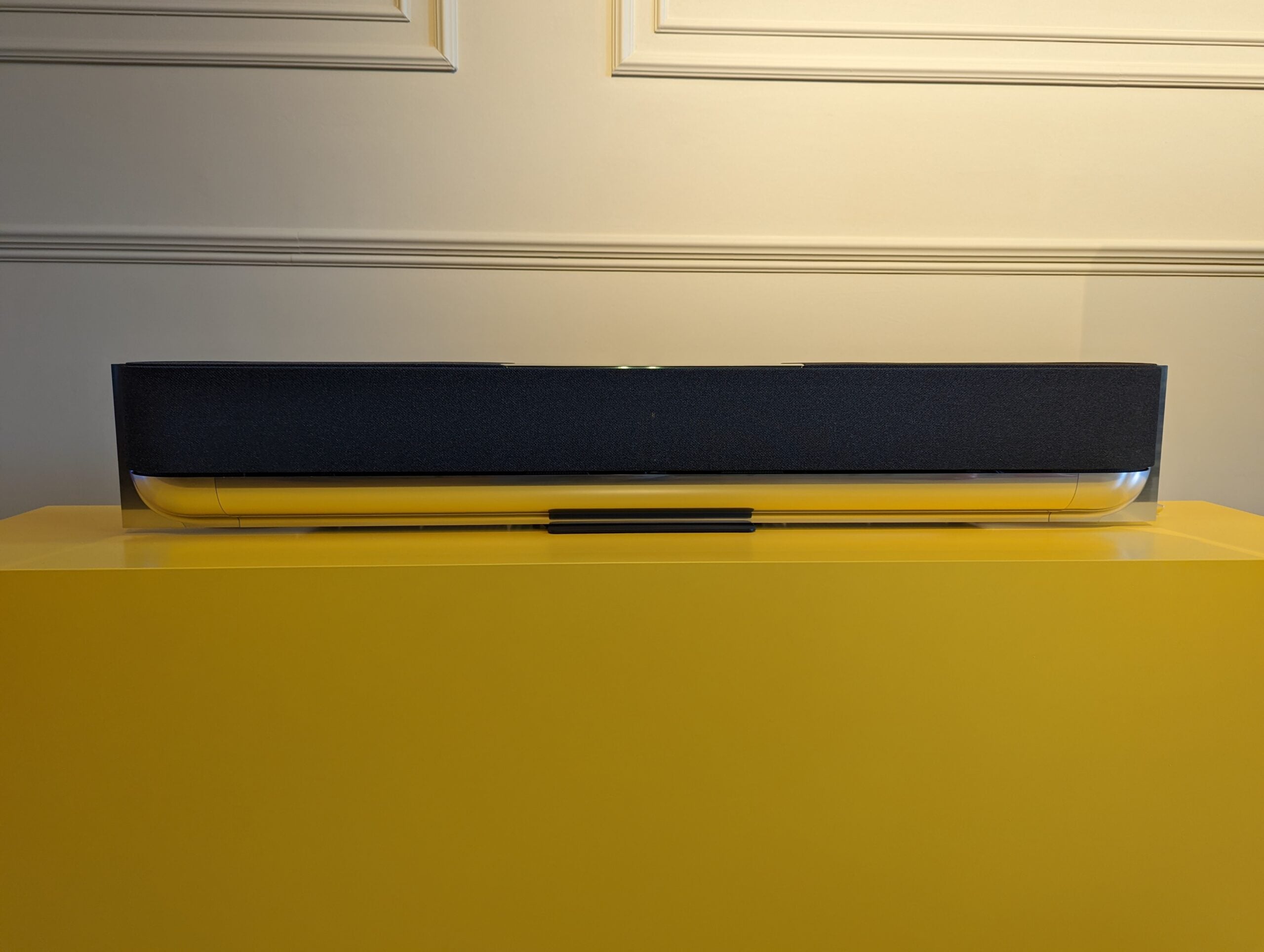The Beosound Theatre is the latest top-of-the-line soundbar from Bang and Olufsen. After a brief listen and play with it at IFA 2022 in Berlin, this is by far one of the most interesting home cinema items I’ve seen in quite some time.
-
16 speaker setupProvides terrific audio -
Dolby Atmos supportFor room filling sound -
eARC connectivityEasy connection to your setup
Availability
- UKRRP: £5590
- USARRP: $6890
- EuropeRRP: €6490
- CanadaTBC
- AustraliaTBC
Introduction
The Beosound Theatre is the latest premium soundbar from iconic audio brand Bang and Olufsen. It’s being marketed as the ultimate soundbar for serious music fans and people that care about design, with the firm claiming it will produce “magical experiences”.
Seeing it as it was unveiled at the IFA trade show in Berlin, it’s definitely one of the most interesting items I’ve seen in quite some time, featuring a distinctive “sail boat inspired” design and an eye-watering £5590 price tag.
This makes it a hard sell for any but the most wealthy buyers and will lead many, myself included, to ask if you really should invest more in your soundbar than a top-of-the-line flagship TV – especially when competing flagship soundbars, like the Sennheiser Ambeo Soundbar and Devialet Dione cost a lot less and performed amazingly when we tested them.
While I haven’t had enough time to fully answer these questions, here’s what I found out about the Theatre after taking it for an early spin at the launch event.
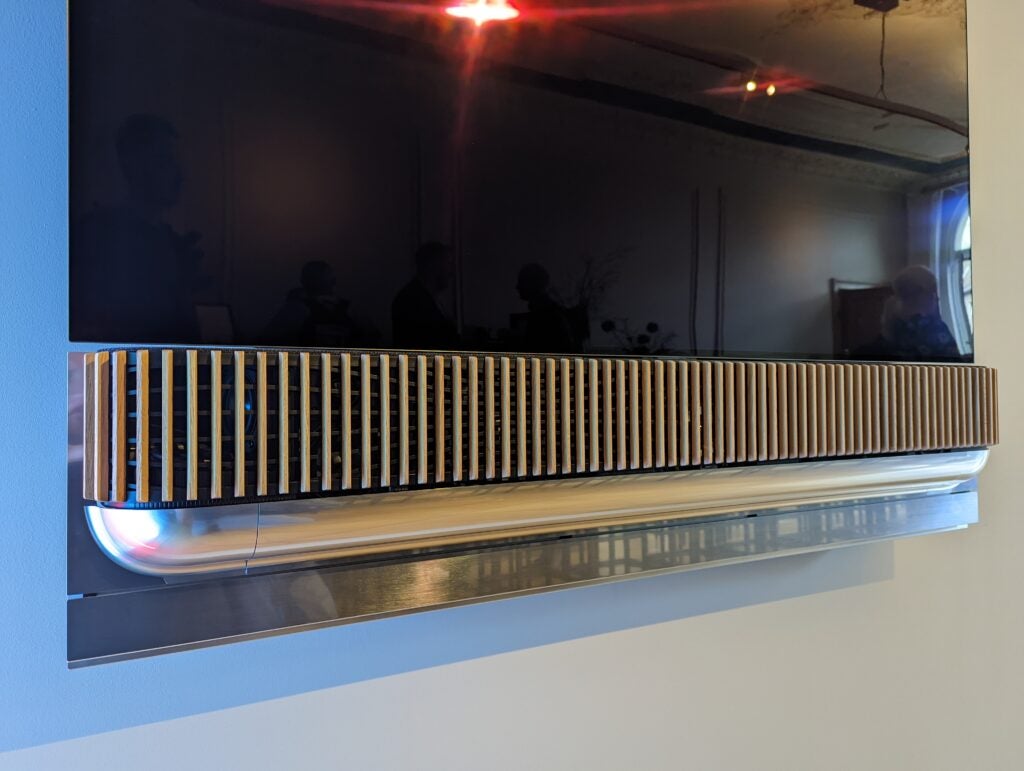
The Beosound Theatre doesn’t have a UK release date yet, but Bang and Olufsen has confirmed it will retail for £5590 / $6890 / €6490 depending on what region you’re in.
That makes it the most expensive soundbar I’ve ever used and in the same league as hardcore audiophile setups from the likes of Ruark and Bluesound.
To put it in context the Sennheiser Ambeo Soundbar and Devialet Dione, which are its two closest competitors when it comes to price cost £2199 and £1990 respectively.
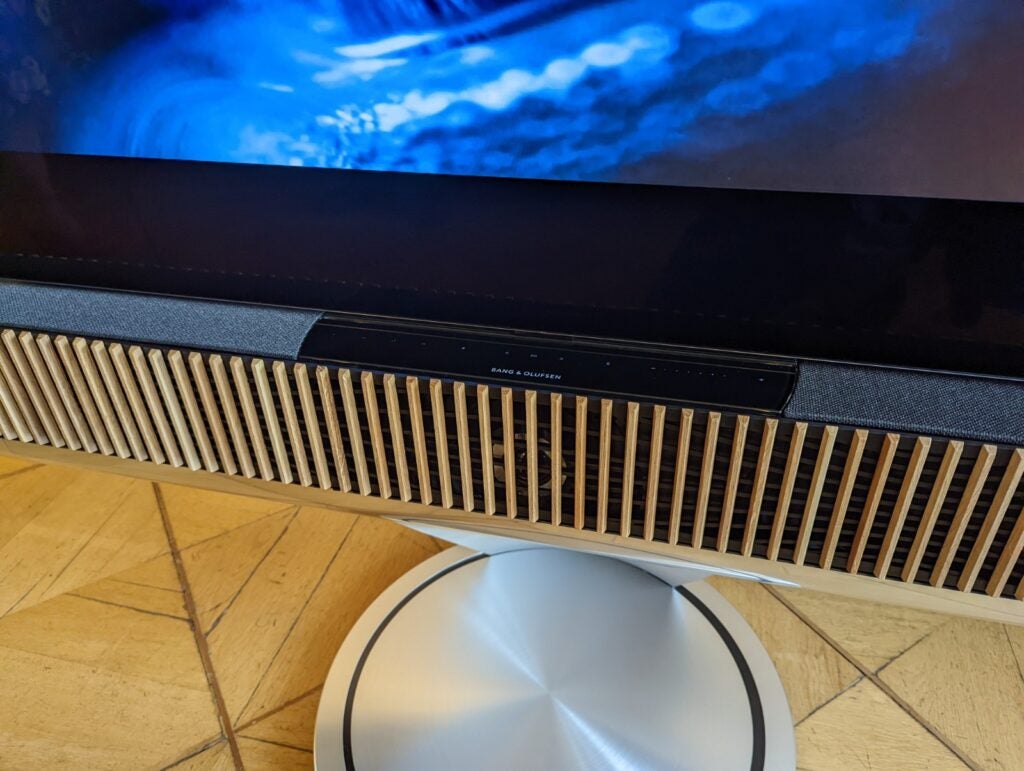
Design
- Sustainable build and design
- Very striking look
B&O has made a few clear changes to the soundbar’s design to justify its high price tag.
The first stemmed from its “sustainable, modular and upgradable design”. The second, its best-in-class sound that, according to reps, will create “magical moments whether you’re listening to music, watching movies or gaming.”
On a sustainability front, there seems to be some truth to this claim, with Bang and Olufsen Mads Kogsgaard Hansen, Head of Product Circularity revealing it is “close” to achieving the bronze cradle-to-cradle sustainable design certification for the product, when asked by Trusted Reviews.
While I’m not overly sure its “sail boat” inspired design will fit in everyone’s living room, with the wooden grates having a slightly distracting look, based on my taste, its modular design also looked impressive when I demoed it.
Relating to the first claim, sustainability is an area B&O is focussing on. The company claims it has created a modular, circular design that it claims will last 10 years minimum. During the demo, there were two key parts to this. The first is the fact it has been designed to let it fit with pretty much every TV size under the sun.
The demo showed Bang and Olufsen reps switch everything from 55 to 75-inch sets using a custom interface bracket. The system wasn’t seamless each time, with it taking a few minutes for someone to slip the connecting parts to the right size and move the TV down into the connecting slot, sometimes with enough force to make me wince.
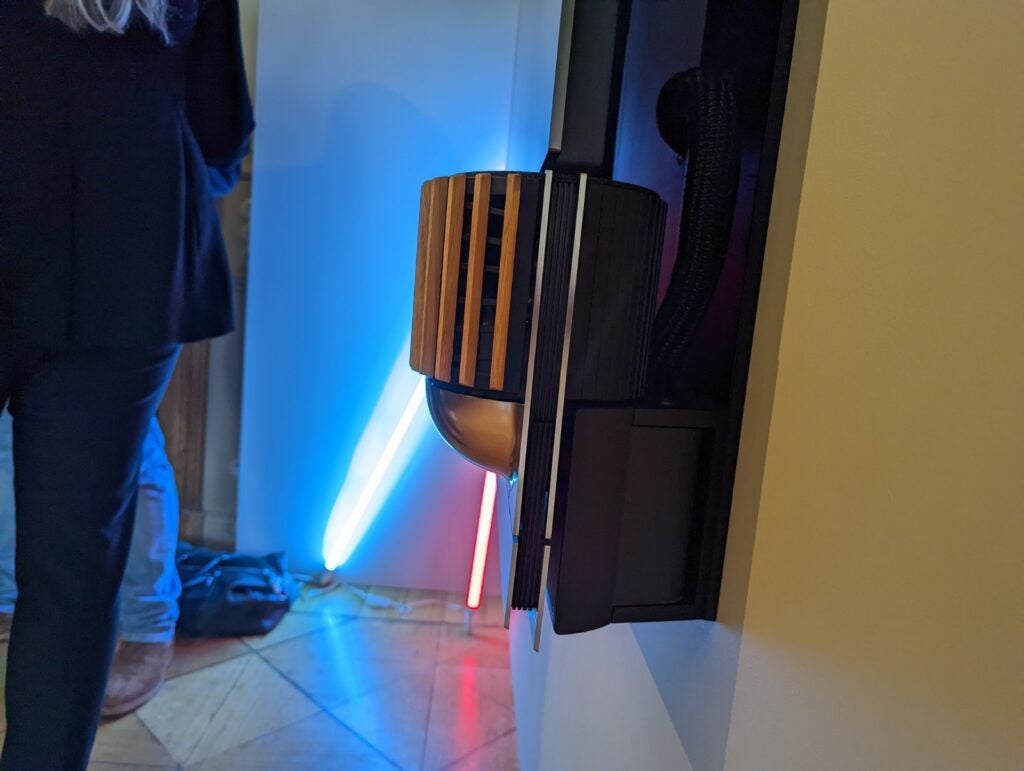
The more important part is the circular design element. This means the soundbar has been designed to be upgradable both from a software and hardware perspective.
Bang and Olufsen confirmed the parts are all connected using common screws and clip fittings, which according to spokespeople on the ground mean it could in theory be upgraded using common tools and official parts. Though the spokesperson strongly recommended not doing this in case you cause damage.
From a software perspective, the company confirmed it’s left “50%” of its computational power unused, so there’s headroom for it to update performance in the future and add connectivity via automatic updates. The software is also built on Linux which has a staple open-source community following and update roadmap, leaving it fairly future-proof from that perspective.
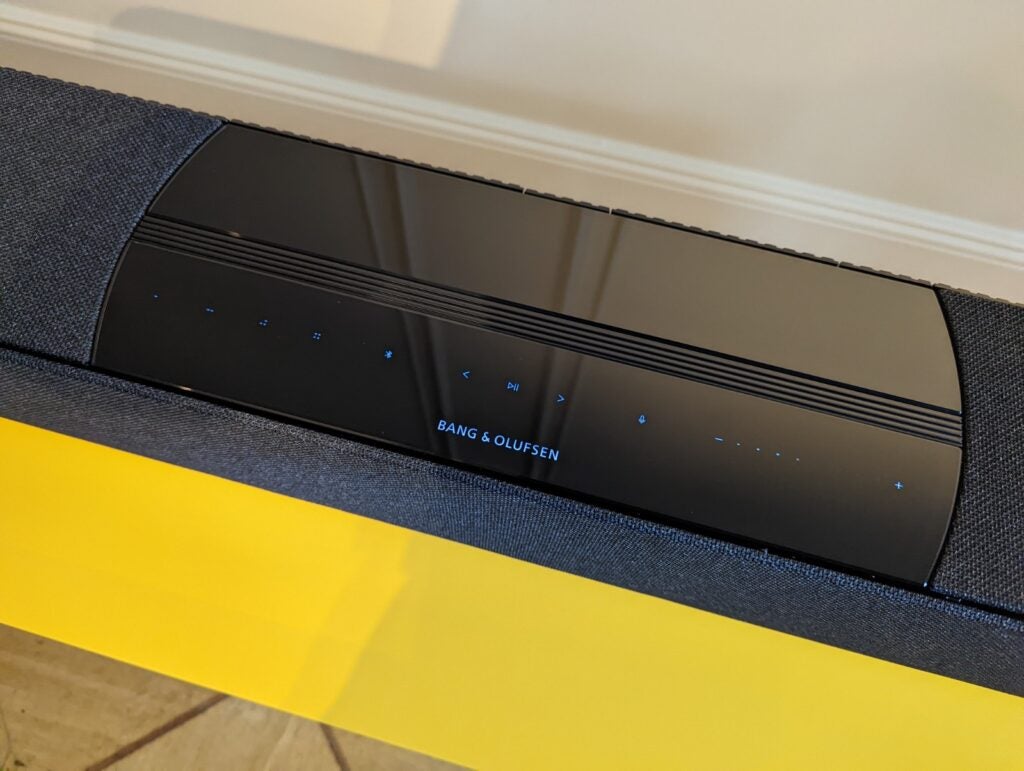
Sound
- 16 speaker array
- Atmos, eARC
- Sounds fantastic
Under the hood the Theatre features a 16 speaker setup. The system combines two custom-made long stroke 6.5-inch woofers, a custom coaxial centre speaker, front and side firing drivers and two up-firing speakers. The set-up is backed by 800 watts of amplification power that provides up to 112dB sound pressure level.
Bang and Olufsen said the system is designed to let the Theatre function as a standalone entertainment system, or as the centre of a multi-speaker setup, with it featuring 8 Powerlink outputs and 8 wireless Powerlink outputs. This in theory lets it connect to 16 external speakers.
For gamers, there’s also eARC offering 4K/120 and 8K/60 passthrough support, which lets it quickly and easily integrate into an Atmos setup or pair it with a PS5 or Xbox Series X.
My testing period was very short so I can’t offer any definitive verdict on overall audio quality quite yet. My testing was limited to listening to five one minute tracks in the speaker’s music setting and a short part of Bohemian Rhapsody with the Theatre as the only source and No Time to Die with it as part of a multiroom setup.
Audio quality was hard to judge in the luxury flat I tested it in, which had a window open. Sitting in the sweet spot I was impressed, however. The music covered a variety of genres including a classic string arrangement, slow pop ballad, upbeat funk song, electronica and hard rock.
In each instance it was hard to fault the Theatre’s performance. The bass in the ballad was wonderfully tight, and powerful. Detail in every test was incredible. Dynamism felt wonderfully impressive with the menacing build of the rock track hitting and the breakdown having enough impact to make me really feel like I was watching it live.
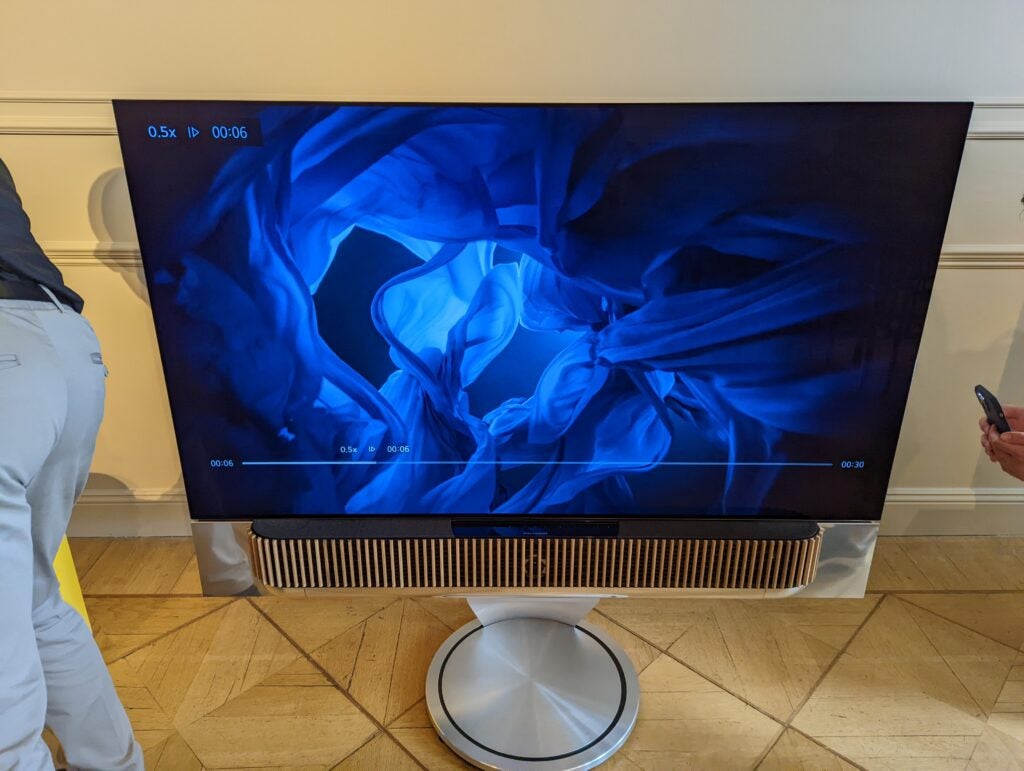
Moving to movies I was impressed in particular with how well it functioned as the centre of a multi-speaker arrangement.
In this arrangement, the Theatre’s own centre channel takes on dialogue duties, with the tweeter mounted directly in front of the midrange. It also uses Bang and Olufsen tech to try and optimise all the speakers in the setup to work better together. Specifically, it uses the Beam Width and Beam Direction Control developed for the Beolab 90 speakers, to distribute the low end evenly among all the paired speakers. This is different to most multi-speaker setups which push the low end to the most powerful speaker.
I didn’t have oodles of time to fully judge how well this worked but it offered pleasing directional and precise audio for me to feel the impact and read the direction of each part of No Time to Die’s soundtrack, even during a heated gunfire scene.
All-in-all I couldn’t find anything to critique when it came to sound quality during my session. I’ll be very keen to see how it performs with prolonged testing and against its closest, but much cheaper, rivals when we get it into our labs.
My only minor annoyance is that despite featuring support for USB-C audio input, and wireless music streaming for all the common options, including Apple AirPlay 2, Bluetooth, a built-in Chromecast and Spotify Connect there was no mention of DTS: X. This is annoying considering as DTS:X supports higher bit-rates than Atmos and I’d really expect it at this price.
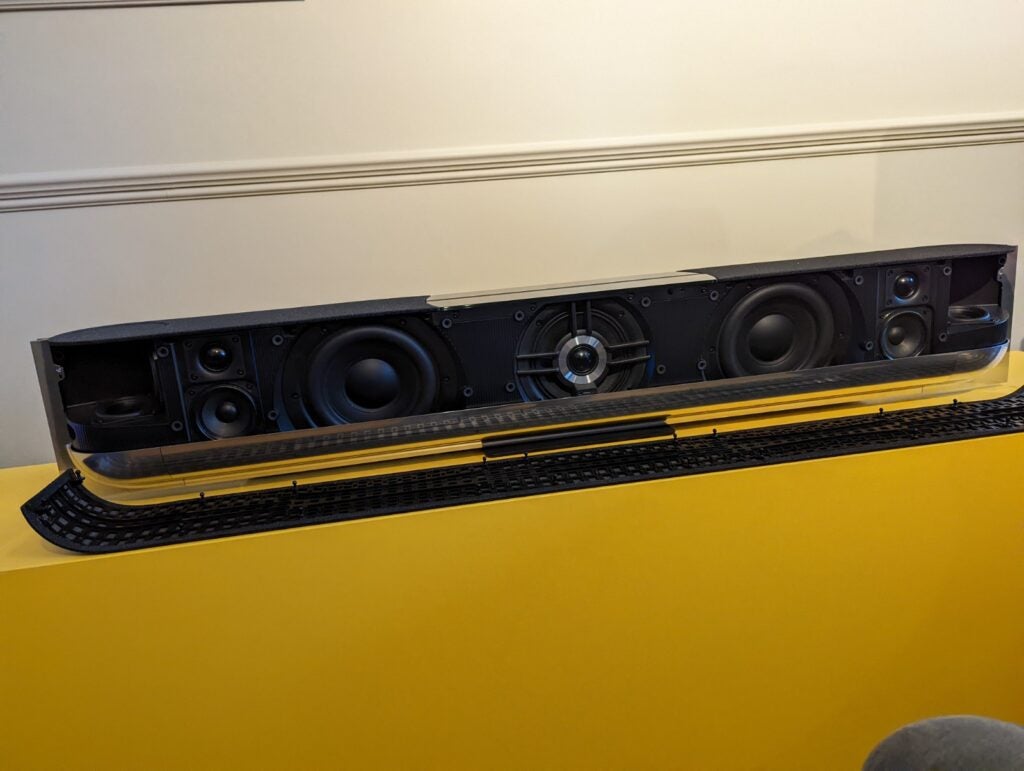
First impressions
The Beosound Theatre is the most interesting soundbar to arrive in years, offering a sustainable modular design, cutting-edge speaker setup and all the bells and whistles you’d expect from a top-of-the-line audio system.
But its price is astronomically high and while it really impressed me during my limited demo, I’d need much more time with it before I could concretely say it’s worth the money.
The Beosound Theatre is the latest top-of-the-line soundbar from Bang and Olufsen. After a brief listen and play with it at IFA 2022 in Berlin, this is by far one of the most interesting home cinema items I’ve seen in quite some time.
-
16 speaker setupProvides terrific audio -
Dolby Atmos supportFor room filling sound -
eARC connectivityEasy connection to your setup
Availability
- UKRRP: £5590
- USARRP: $6890
- EuropeRRP: €6490
- CanadaTBC
- AustraliaTBC
Introduction
The Beosound Theatre is the latest premium soundbar from iconic audio brand Bang and Olufsen. It’s being marketed as the ultimate soundbar for serious music fans and people that care about design, with the firm claiming it will produce “magical experiences”.
Seeing it as it was unveiled at the IFA trade show in Berlin, it’s definitely one of the most interesting items I’ve seen in quite some time, featuring a distinctive “sail boat inspired” design and an eye-watering £5590 price tag.
This makes it a hard sell for any but the most wealthy buyers and will lead many, myself included, to ask if you really should invest more in your soundbar than a top-of-the-line flagship TV – especially when competing flagship soundbars, like the Sennheiser Ambeo Soundbar and Devialet Dione cost a lot less and performed amazingly when we tested them.
While I haven’t had enough time to fully answer these questions, here’s what I found out about the Theatre after taking it for an early spin at the launch event.

The Beosound Theatre doesn’t have a UK release date yet, but Bang and Olufsen has confirmed it will retail for £5590 / $6890 / €6490 depending on what region you’re in.
That makes it the most expensive soundbar I’ve ever used and in the same league as hardcore audiophile setups from the likes of Ruark and Bluesound.
To put it in context the Sennheiser Ambeo Soundbar and Devialet Dione, which are its two closest competitors when it comes to price cost £2199 and £1990 respectively.

Design
- Sustainable build and design
- Very striking look
B&O has made a few clear changes to the soundbar’s design to justify its high price tag.
The first stemmed from its “sustainable, modular and upgradable design”. The second, its best-in-class sound that, according to reps, will create “magical moments whether you’re listening to music, watching movies or gaming.”
On a sustainability front, there seems to be some truth to this claim, with Bang and Olufsen Mads Kogsgaard Hansen, Head of Product Circularity revealing it is “close” to achieving the bronze cradle-to-cradle sustainable design certification for the product, when asked by Trusted Reviews.
While I’m not overly sure its “sail boat” inspired design will fit in everyone’s living room, with the wooden grates having a slightly distracting look, based on my taste, its modular design also looked impressive when I demoed it.
Relating to the first claim, sustainability is an area B&O is focussing on. The company claims it has created a modular, circular design that it claims will last 10 years minimum. During the demo, there were two key parts to this. The first is the fact it has been designed to let it fit with pretty much every TV size under the sun.
The demo showed Bang and Olufsen reps switch everything from 55 to 75-inch sets using a custom interface bracket. The system wasn’t seamless each time, with it taking a few minutes for someone to slip the connecting parts to the right size and move the TV down into the connecting slot, sometimes with enough force to make me wince.

The more important part is the circular design element. This means the soundbar has been designed to be upgradable both from a software and hardware perspective.
Bang and Olufsen confirmed the parts are all connected using common screws and clip fittings, which according to spokespeople on the ground mean it could in theory be upgraded using common tools and official parts. Though the spokesperson strongly recommended not doing this in case you cause damage.
From a software perspective, the company confirmed it’s left “50%” of its computational power unused, so there’s headroom for it to update performance in the future and add connectivity via automatic updates. The software is also built on Linux which has a staple open-source community following and update roadmap, leaving it fairly future-proof from that perspective.

Sound
- 16 speaker array
- Atmos, eARC
- Sounds fantastic
Under the hood the Theatre features a 16 speaker setup. The system combines two custom-made long stroke 6.5-inch woofers, a custom coaxial centre speaker, front and side firing drivers and two up-firing speakers. The set-up is backed by 800 watts of amplification power that provides up to 112dB sound pressure level.
Bang and Olufsen said the system is designed to let the Theatre function as a standalone entertainment system, or as the centre of a multi-speaker setup, with it featuring 8 Powerlink outputs and 8 wireless Powerlink outputs. This in theory lets it connect to 16 external speakers.
For gamers, there’s also eARC offering 4K/120 and 8K/60 passthrough support, which lets it quickly and easily integrate into an Atmos setup or pair it with a PS5 or Xbox Series X.
My testing period was very short so I can’t offer any definitive verdict on overall audio quality quite yet. My testing was limited to listening to five one minute tracks in the speaker’s music setting and a short part of Bohemian Rhapsody with the Theatre as the only source and No Time to Die with it as part of a multiroom setup.
Audio quality was hard to judge in the luxury flat I tested it in, which had a window open. Sitting in the sweet spot I was impressed, however. The music covered a variety of genres including a classic string arrangement, slow pop ballad, upbeat funk song, electronica and hard rock.
In each instance it was hard to fault the Theatre’s performance. The bass in the ballad was wonderfully tight, and powerful. Detail in every test was incredible. Dynamism felt wonderfully impressive with the menacing build of the rock track hitting and the breakdown having enough impact to make me really feel like I was watching it live.

Moving to movies I was impressed in particular with how well it functioned as the centre of a multi-speaker arrangement.
In this arrangement, the Theatre’s own centre channel takes on dialogue duties, with the tweeter mounted directly in front of the midrange. It also uses Bang and Olufsen tech to try and optimise all the speakers in the setup to work better together. Specifically, it uses the Beam Width and Beam Direction Control developed for the Beolab 90 speakers, to distribute the low end evenly among all the paired speakers. This is different to most multi-speaker setups which push the low end to the most powerful speaker.
I didn’t have oodles of time to fully judge how well this worked but it offered pleasing directional and precise audio for me to feel the impact and read the direction of each part of No Time to Die’s soundtrack, even during a heated gunfire scene.
All-in-all I couldn’t find anything to critique when it came to sound quality during my session. I’ll be very keen to see how it performs with prolonged testing and against its closest, but much cheaper, rivals when we get it into our labs.
My only minor annoyance is that despite featuring support for USB-C audio input, and wireless music streaming for all the common options, including Apple AirPlay 2, Bluetooth, a built-in Chromecast and Spotify Connect there was no mention of DTS: X. This is annoying considering as DTS:X supports higher bit-rates than Atmos and I’d really expect it at this price.

First impressions
The Beosound Theatre is the most interesting soundbar to arrive in years, offering a sustainable modular design, cutting-edge speaker setup and all the bells and whistles you’d expect from a top-of-the-line audio system.
But its price is astronomically high and while it really impressed me during my limited demo, I’d need much more time with it before I could concretely say it’s worth the money.



















